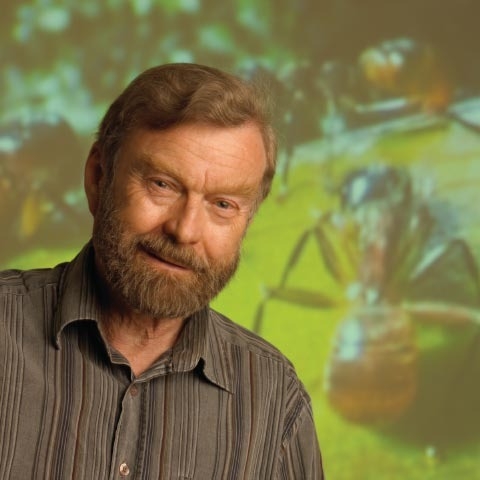- Author: Kathy Keatley Garvey

Bert Hölldobler, an evolutionary biologist based at Arizona State University who researches the evolution and social organization in ants, will discuss "The Superorganism: Communication, Cooperation and Conflict in Ant Societies" at the UC Davis Department of Entomology and Nematology's seminar on Wednesday, April 17 at 4:10 p.m. in Room 122 of Briggs Hall.
Hölldobler says that colonies that are "true superorganisms, show great cooperation among their nest mates and exhibit fierce aggression against neighboring conspecific colonies and display complex territorial strategies."
His experimental and theoretical contributions cover sociobiology, behavioral ecology, and chemical ecology. "His primary study subjects are social insects and in particular ants," according to Wikipedia. "His work has provided valuable insights into mating strategies, regulation of reproduction, the evolution of social parasitism, chemical communications, and the concept of 'superorganisms.'"
Hölldobler and co-author E. O. Wilson won the Pulitzer Prize for non-fiction writing in 1990 for their book, The Ants. They also co-authored The Superorganism: The Beauty, Elegance, and Strangeness of Insect Societies and Journey to the Ants: A Journey of Scientific Exploration. Hölldobler is also the author of The Leafcutter Ants.
Born in Bavaria, Germany on June 25, 1936, Bert studied biology and chemistry at the University of Würzburg. He wrote his doctoral thesis on the social behavior of the male carpenter ant and their role in the organization of carpenter ant societies.
Hölldobler began his academic career at the University of Frankfurt in 1971 as a professor of zoology. From 1973 to 1990 he served as professor of biology and the Alexander Agassiz professor of zoology at Harvard University, Cambridge, Mass. Hölldobler returned to Germany in 1989 to accept the chair of behavioral physiology and sociobiology at the Theodor-Boveri-Institute of the University of Würzburg.
From 2002 to 2008, Hölldobler was an Andrew D. White Professor-at-Large at Cornell University, Ithaca, N.Y. Since his retirement in 2004, he has worked at Arizona State University (ASU) as a professor and research scientist. A Regents' and Foundation professor, he is one of the founders of the Social Insect Research Group (SIRG) and of the Center for Social Dynamics and Complexity.
The seminars are coordinated by medical entomologist/assistant professor Geoffrey Attardo and take place at 4:10 p.m. every Wednesday through June 5 in 122 Briggs Hall. (See list of seminars)




Predicting the sizes and shapes of sufficiently developed human based
super-organisms that would be roaming space eons hence, may be
considered a purely hypothetical exercise of no immediate or future
value to mankind .Nevertheless I intend to undertake this vain
exercise of extrapolating their size from lower levels of organization
for sheer curiosity. As for their shapes, I will make a guess taking
into consideration the gravitational forces generated by their own mass.
The extrapolation of sizes from lower levels of organization would be
based on the interplay of the following three factors: the size and
number of units at each level of organization, (2) the speed limit of
communication within each level, and(3) the kinetics of, and time
perception/ /by organisms at each level.
(1) The size and the number of units.
If a geometric progression governing the ratio of size between any two consecutive levels of organization, or the ratio of their unit
populations were to be discovered, then it would be a very easy matter
to calculate the size of a human-based super-organism and the number of
its humanoid and other organism populations.
For example let's say the size of an average human cell / /is 20u
(microns) and that of an adult human being,1700000u (1.7meters). the
ratio of their sizes would be 20/1700000 = 1/85000. If this were the
ratio of the geometric progression governing at all * *consecutive
levels (ie. atoms/molecules = 1/85000, molecule/organelles l/85000,
organelles/cells = 1/85000 etc...), then the size of a super-organism
should be in the vicinity of l.7x85000- 144000 meters (144km) long, were
the humanoids in it as densely packed as are human cells.
On the other hand its population would be in the vicinity of 10^14
humanoids and other multi-cellular organisms this number being the
approximate cell population in an adult human being. There would
naturally be many different types of super-organisms in various sizes
and shapes as is the case with multi-cellular organisms.
(2) The speed limit of communication.
Within cells (Holo 4)* , the fastest moving communication is probably
cell membrane depolarization in the order of centimeters/second. Within
humans (Holo 5), the same can be said of nerve conduction, the fastest
of which is in the vicinity of 80 meters/second. Within society (Holo 6)
the speed limit of communication is definitely 300000 km/second, i.e.
the speed of light ( telephone, radio, television and simple vision).
Thus if there is a correlation between the size of an organism and the
speed limit of its internal communication and I believe there should
be then we can say that mans size is 1.7/80 or 1/47 times his fastest per second nerve conduction. Extrapolating from this, /the /size of a
multi-humanoid super-organism would be 1/47 x the velocity of light the
speed limit of its internal communication; 300000 x 1/47 = 6375 km long.
This is a much larger size than the one (144km) obtained in the former
calculation. The discrepancy would allow each humanoid in a
super-organism a volume of 421675 cubic meters of free space to function
in, unlike cells which are densely packed in our bodies.
(3) The kinetics and perception of time.
To understand how the kinetics and time perception in super-organisms
may have a bearing on their sizes, lets take the simple act of dodging
a projectile by man and its parallel of evading collision with a large
meteor by a super-organism in space. A man who sees a stone coming in
his direction can in less than a second the time it takes to see the
stone , realize its danger and execute the proper maneuver give way
to it.
Lets imagine that a super-organism has detected a meteor traveling at
1000km/sec towards it, one hour before the expected time of collision;
On its time scale this one hour may be one second. If it accelerated a
1000km long endangered section of its body, perpendicularly to the path
of the meteor , at 1 meter/sec, creating a g/10), it would have moved
6480 km during that golden hour well out of the way of the meteor .
This one meter/sec acceleration would be barely perceptible by the
humanoids in the super-organism.
(3)
Finally, /we may make a guess as for the shape of these huge super
organisms. It would be very difficult for them to maintain a globular
shape because they would collapse on themselves by auto-gravity. I would
therefore opt for very long cylindrical (serpentine) organisms that
moved arrow-like along their long axis. They would thus be able, if they
wished, to approach a planet tangentially and wind themselves (perhaps
several fold) in orbit around it.
Allow me now to make a closing conjecture! Could the rings of Saturn,
perchance, be the skeletons of long dead super-organisms?
Table 1: The Organizational Spectrum of Matter
Intergalactic Organisms
Holo 6
Multi-humanoid Organisms (Super-organisms)
Holo 5
Man , Multi-cellular organisms
Holo 4
Cells, Unicellular Organisms
Holo 3
Organelles (Viruses, Bacteria)
Holo 2
Molecules (Proteins, Enzymes, DNA)
Holo 1
Atoms ( All elements on the Periodic table )
Holo 0
Protons, Neutrons
Holo -1
Subatomic particles
Holo -2
Sub-sub-atomic Particles
Holo - ¥
Pure energy
Boghos L. Artinian MD
137 views